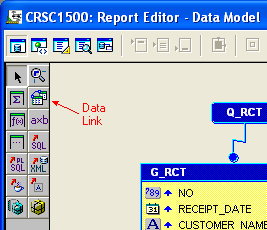Editing Oracle Reports
If you’re like me, the above picture will probably have given you a frisson of dread. Just a little. The example here is not a very complicated report, just a few repeating groups based on quite a nice data model. What catches me every time, however, is a few little apparent quirks in Oracle Reports – and I’ve decided to post them here so that I’ll remember them next time I have to maintain someone’s reports. I keep forgetting them because I don’t have to work with Oracle Reports very often.
(These instructions are for Oracle Reports 10g – 9.0.4.0.33)
- When you change the structure of the query, it will often change the order of the labels in the model editor – and the order is important. So, don’t forget to check that the order of the columns matches the order of the columns in the query.
- Don’t forget to add the data links between the query groups. Otherwise, you may find the report takes a looooong time to run – if the status page says something like “Generating page 557,634…” for a report you expected to fit on 1 page, this may be the cause.
- If you modify a query, you may find that some or all data links to that group will now be invalid (e.g. if you add a GROUP BY to a query that is a child group, you may find that at runtime it will simply ignore the data link entirely – leading to the dreaded million-page report). You may have to delete the data links and recreate them. To create a data link:
- Click the Data Link icon (View -> Tool Palette)

- Mouse down on the join column in the parent group
- Drag the line to the join column in the child group, and release.
If the Data Link cannot be created for some reason (e.g. because of a Group By in the child group), Reports will then create a generic “group link” – which means you need to add the join criteria manually to the WHERE clause in the child query.
- Click the Data Link icon (View -> Tool Palette)
- When adding a calculated field, don’t forget to change the default data type from Number to Char or Date if applicable. Otherwise, you’ll probably get something like “Invalid value for CF_BLA” at runtime.
- When editing the print layout, don’t forget to review these important modes accessible from the toolbar. In particular: Confine On / Confine Off, Flex On / Flex Off, Select Parent Frame.
 For example, to move something from one parent frame to another:
For example, to move something from one parent frame to another:
- Select the object.
- Set Confine Off.
- Move the object to the desired location.
- Set Confine On.
- See if the hierarchy is now all messed up. If so, Undo and try again – make sure the object is fully within the target parent before you set Confine On.

